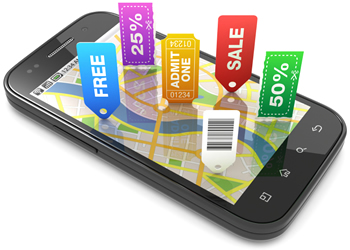Shoppers are up to 45 percent more likely to buy your product or service while they’re looking it up on their smartphones or tablets away from home or work, according to a new Forbes report.
For retailers and other marketers, this means that smart, location based marketing is key to motivating shoppers to buy products either in-store or on their smartphones.
The report, called “Location: A Strategic Marketing Imperative”, features interviews with major marketing executives, analysis by Forbes Insights, and findings from a recent study by mobile marketing service provider xAd. Although the report is commissioned by xAd, its findings and examples are still interesting and for the most part, objective.
As mobile usage grows, shoppers demand more
By 2018, 2.5 billion people–that’s a third of the planet’s population–will be using smartphones, according to eMarketer. But that doesn’t mean all of those people will start buying things online. Today, 90 percent of retail sales transactions are still in brick-and-mortar stores, according to the U.S. Department of Commerce.
 The ten-plus percent of us who do shop online or with mobile apps are increasingly deal savvy and willing to give our location for a mobile coupon or loyalty points. And we’re used to doing comparative research while mobile, thanks to popular apps like Uber, Tinder, Groupon, and Yelp.
The ten-plus percent of us who do shop online or with mobile apps are increasingly deal savvy and willing to give our location for a mobile coupon or loyalty points. And we’re used to doing comparative research while mobile, thanks to popular apps like Uber, Tinder, Groupon, and Yelp.
So whether we’re mapping the nearest great restaurant, getting a ride fare estimate, collecting a mobile coupon, or swiping for the closest love connection, we use location data to shop, date and travel. Even while mobile, we expect in-the-moment, personalized and relevant shopping experiences.
For marketers, this new breed of mobile-dependent, highly demanding consumer is a prime opportunity to engage and activate customers. According to the Forbes report, location-based marketing is crucial to the goals of creating immediate purchase incentives and fostering a more personal engagement. That’s true whether a retailer wants to suggest a store location, promote a new product, or just stay relevant and useful to consumers.
Key location based marketing takeaways
The Forbes report also includes examples of location based marketing by major companies like Taco Bell and Wells Fargo, plus interviews with top marketing executives about the technology. For example, McDonald’s China has been wildly successful in using location based marketing to promote new ice cream flavors to millions of nearby smartphone users. Because ice cream is an impulsive “on the spot” purchase, traditional media ads just don’t work so well.
Some of the report’s key takeaways:
Many use mobile devices to make purchase decisions.
About 44 percent of consumers polled said that their smartphones or tablets are the most essential tool to their purchase decision, according to xAd’s “Mobile Path to Purchase” study.
Mobile product research indicates purchase intent.
Shoppers who are researching products and services on their smartphones while on the go demonstrate more intent to purchase something quickly. In fact, such mobile researchers are 45 percent more likely to make a purchase within the hour over people who research products at home, according to the xAd study. And if marketers can act quickly through location based marketing incentives, they can potentially increase that rate.
In-person purchases aren’t going away.
Because 90 percent of retail transactions still happen offline, in-store shopping won’t be going away soon. Retailers then shouldn’t seek to replace the offline experience, but instead provide a faster, more seamless purchase process for mobile-savvy shoppers. The right location based marketing strategy can enhance the customer experience by nurturing brand-customer connections in-store.
Location is a state of mind.
Where people are–or where they have been–can provide powerful context about their needs as consumers, the best ways to tailor messages and offerings to them, and their immediate intent to purchase.
Foot traffic measurement is a near-term reality.
Retailers will soon be able to use location data to not only measure how much foot traffic a mobile promotion drives to a store, but also where shoppers are most likely to head next based on their previous buying patterns and behavior. Using this predictive information, retailers can attempt to entice consumers away from competitors with location-targeted mobile campaigns.
Mobile marketing helps level the playing field.
Because location based marketing campaigns are often much cheaper than traditional broadcast or print campaigns, they are more affordable for smaller companies with smaller budgets. But of course the cost can still vary widely–especially when location based marketing is tied to high-tech, in-store promotional setups.
For the price of your name and email address (but ironically not your location), you can download the full 8-page Forbes Insights / xAd report here.





